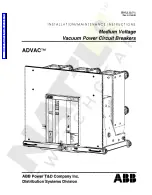
IB131009EN
Instruction
Book
Page 26
SECTION 5: DESCRIPTION AND
OPERATION
Eaton Type W-VAC and W-VACW are horizontal
drawout circuit breakers while the W-VACR is a fixed
circuit breaker. They are all designed specifically to IEC
56 and KEMA certified to IEC Standards, includ- ing
their earthing system.
W-VAC and W-VACW breakers are both available in
three mounting configurations. These include single tier
designs and double tier designs for use in medal-clad
switchgear, and a basic element design for use in retro-
fitting. For the single tier design, the basic breaker ele-
ment is mounted on a carriage assembly. The basic
breaker element is mounted on a cradle assembly for
the double-tier design. The carriage assembly and the
cradle assembly both incorporate the racking mecha-
nism and required safety interlocks. The W-VACR fixed
circuit breaker is available for a single tier configuration
only.
For drawout breakers, the basic breaker element, the
breaker element with a carriage assembly, and the
breaker element with a cradle assembly are designed to
accept a variety of faceplates or covers. This permits
the breakers to be very flexible with respect to the type
of structure used to form the final switchgear assembly.
Possibility 1 :
The basic breaker element, by itself, is
used for retrofitting purposes (Figures
3-3 and 3-4
).
Possibility 2:
The basic breaker element combined with
a carriage assembly is used for single tier switchgear.
The breaker and carriage combination, however, can be
utilized in a flush mounted configuration (Figure
5-1
) or
a behind the door configuration. The flush mounted
design cover forms a deadfront design with the struc-
ture, once the breaker is racked into the fully connected
position.
Possibility 3 :
The basic breaker element combined with
a cradle assembly is used for double tier switchgear.
This combination is only for use in a behind the door
configuration (Figure
5-2
).
W-VAC breakers utilize Eaton vacuum inter- rupters to
close and open the primary circuit. The mech- anism is
a front mounted, spring stored energy type, which is
common to all ratings. This one front mounted
mechanism is easy to inspect, accessible for servicing
and requires a minimum of spare parts. Because of the
inherent long life characteristics of the vacuum inter-
rupters and the highly reliable spring stored energy
mechanism, W-VAC and W-VACW circuit breakers pro-
Figure 5-1 Flush mounted configuration.
vide long trouble free service with a minimum of mainte-
nance.
The primary insulation used throughout both breaker
designs is flame retardant and track resistant glass poly-
ester.
5-1 INTERRUPTER ASSEMBLY
Vacuum interrupters are mounted vertically and support-
ed from the fixed stem clamped to the top conductor
(Figure
5-3
for W-VAC) and (Figure
5-9
for W-VACW).
The current transfer system consists of a series of tin-
plated, high-conductivity copper leaf conductors that are
pressed onto the movable interrupter stem.This pro-
vides a multipoint contact resulting in low electrical and
thermal resistance. Since the current transfer from the
movable stem to the breaker main conductor is a non-
sliding design, no maintenance is required.
5-1.1 VACUUM INTERRUPTER
All the circuit breakers utilize vacuum interrupters for
interruption and switching functions. The primary differ-
ence between the different breaker types is the vacuum
interrupter configuration, which results in different rat-
ings (Tables
1.1
and
1.2
). Vacuum interruption offers
the advantages of enclosed interrupters, reduced size
and weight, short interrupting time, long life, reduced
Содержание 120W-VAC16
Страница 2: ......
Страница 40: ...Instruction Book Page 34 IB131009EN Figure 5 7 Typical DC and AC control schemes ...
Страница 61: ......





































